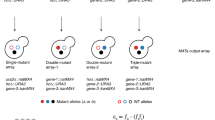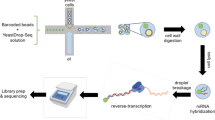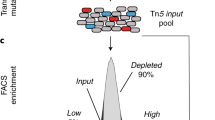Abstract
A quantitative and highly parallel method for analysing deletion mutants has been developed to aid in determining the biological function of thousands of newly identified open reading frames (ORFs) in Saccharomyces cerevisiae. This approach uses a PCR targeting strategy to generate large numbers of deletion strains. Each deletion strain is labelled with a unique 20–base tag sequence that can be detected by hybridization to a high–density oligonucleotide array. The tags serve as unique identifiers (molecular bar codes) that allow analysis of large numbers of deletion strains simultaneously through selective growth conditions. Hybridization experiments show that the arrays are specific, sensitive and quantitative. A pilot study with 11 known yeastgenes suggests that the method can be extended to include all of the ORFs in the yeast genome, allowing whole genome analysis with a single selective growth condition and a single hybridization.
This is a preview of subscription content, access via your institution
Access options
Subscribe to this journal
Receive 12 print issues and online access
$209.00 per year
only $17.42 per issue
Buy this article
- Purchase on SpringerLink
- Instant access to full article PDF
Prices may be subject to local taxes which are calculated during checkout
Similar content being viewed by others
References
Oliver, S.G. From DNA sequence to biological function. Nature 379, 597–600 (1996).
Rothstein, R., Targeting, disruption, replacement, and allele rescue: integrative DNA transformation in yeast. Meth. Enzymol. 194, 281–301 (1991).
Baudin, A., Ozier-Kalogeropoulos., O., Denouel, A., Lacroute, F. & Cullin, C. A simple and efficient method for direct gene deletion in Saccharomyces cerevisiae. Nucl. Acids Res. 21, 3329–3330 (1993).
Burns, N. et al. Large-scale analysis of gene expression, protein localization, and gene disruption in Saccharomyces cerevisiae. Genes Dev. 8, 1087–1105 (1994).
Smith, V., Botstein, D. & Brown, P.O. Genetic footprinting: a genomic strategy for determining a gene's function given its sequence. Proc. Natl. Acad. Sci. USA 92, 6479–6483 (1995).
Hensel, M. et al. Simultaneous identification of bacterial virulence genes by negative selection. Science 269, 400–403 (1995).
Fodor, S.P. et al Light-directed, spatially addressable parallel chemical synthesis. Science 251, 767–773 (1991).
Pease, A.C. et al. Light-generated oligonucleotide arrays for rapid DNA sequence analysis. Proc. Watt. Acad. Sci. USA 91, 5022–5026 (1994).
Lockhart, D.J. et al. Expression monitoring by hybridization to high-density oligonucleotide arrays. Nature Biotech, (in the press).
Wach, A., Brachat, A., Pohlmann, R. & Philippsen, P. New heterologous modules for classical or PCR-based gene disruptions in Saccharomyces cerevisiae . Yeast 10, 1793–1808 (1994).
Huxley, C., Green, E.D. & Dunham, I. Rapid assessment of S.cerevisiae mating type by PCR. Trends Genet. 6, 236 (1990).
Lashkari, D.A.,, Hunicke-Smith, S.P., Norgren, R.M., Davis, R.W. & Brennan, T. An automated multiplex oligonucleotide synthesizer: development of high-throughput, low-cost DNA synthesis. Proc. Natl Acad. Sci. USA 92. 7912–7915 (1995).
Lipshutz, R.J. et al. Using oligonucleotide probe arrays to access genetic diversity. BioTech. 19, 442–447 (1995).
Jiminez, A. & Davies, J. Expression of transposable antibiotic resistance elements in Saccharomyces Nature 287, 869–871 (1980).
Sherman, F., Fink, G.R., Hicks J.B. Methods in yeast genetics: A laboratory manual (Cold Spring Harbor Laboratory (Cold Spring Harbor, New York, 1986).
Gietz, R.D. & Woods, R.A. High efficiency transformation with lithium acetate in Molecular Genetics of Yeast, A Practical Approach (ed. Johnston, J.R.),121–134 (IRL Press, Oxford, UK, 1994).
Hoffman, C.S. & Winston, F. A ten-minute DNA preparation from yeast efficiently releases autonomous plasmids for transformation of Escherichia coli . Gene 57, 267–272 (1987).
Author information
Authors and Affiliations
Rights and permissions
About this article
Cite this article
Shoemaker, D., Lashkari, D., Morris, D. et al. Quantitative phenotypic analysis of yeast deletion mutants using a highly parallel molecular bar–coding strategy. Nat Genet 14, 450–456 (1996). https://doi.org/10.1038/ng1296-450
Received:
Accepted:
Issue Date:
DOI: https://doi.org/10.1038/ng1296-450
This article is cited by
-
Scalable design of orthogonal DNA barcode libraries
Nature Computational Science (2024)
-
Imaging-based screens of pool-synthesized cell libraries
Nature Methods (2021)
-
An inducible CRISPR interference library for genetic interrogation of Saccharomyces cerevisiae biology
Communications Biology (2020)
-
Characterization of survival and stress resistance in S. cerevisiae mutants affected in peroxisome inheritance and proliferation, Δinp1 and Δpex11
Folia Microbiologica (2020)



